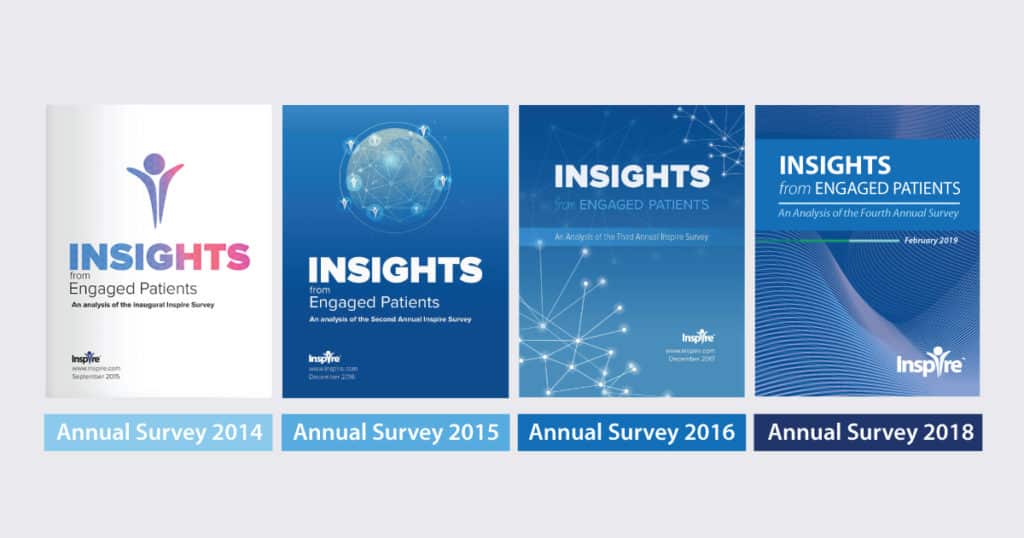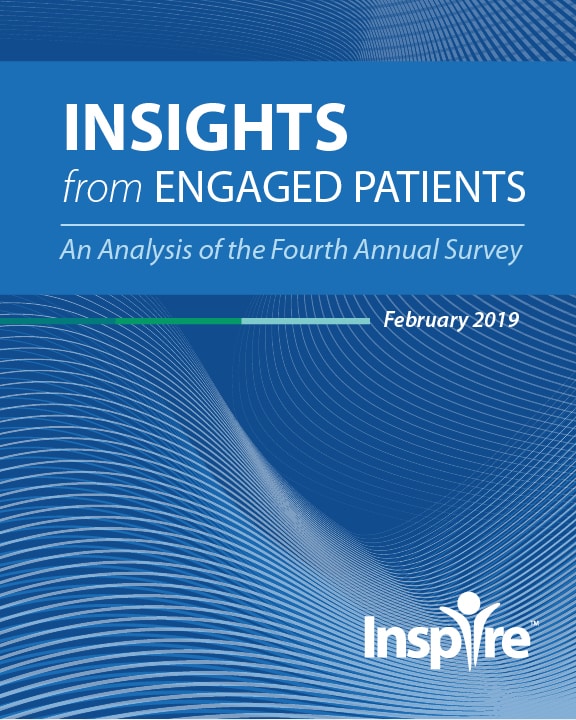A Look Across Inspire’s Annual Surveys

Over the past four years, Inspire has conducted an annual survey of its members. Participation has been high, with an average of 10,000 members participating each year. This large pool of data over time provides a unique glimpse at the changes that have occurred in social media use in healthcare.
The use of social media and mobile apps among patients and caregivers has changed dramatically over the past four years and Inspire’s annual survey data supports this. For example, in 2014, 70 percent of the over 13,000 respondents had never used mobile apps for health.1 Now, that number is down to forty percent.2 In Inspire’s First Annual Survey, 67 percent of participants said they use social media for research and support.1 That number has risen to 88 percent in Inspire’s Fourth Annual Survey.2
According to the Fourth Annual Survey, 41 percent of participants have asked for and received advice on health on social media and 45 percent have given health related advice on social media.2 While these figures are similar to numbers seen in previous surveys, this year – of those seeking advice – 82 percent were interested in getting guidance concerning treatment options and 75 percent of those who did this used that advice in their treatment decision-making.2 These figures have risen since the second survey when 80 percent were interested in getting guidance concerning treatment options but only 67 percent used that advice in their decision-making.3 Even though similar amounts of people are looking for and giving advice, they are using social media to get advice on a greater number of health-related topics.2
What these figures suggest is that people are becoming more and more comfortable with sharing advice on social media and using that advice to help them with their treatment decisions. How does this impact the patient-physician relationship? Other research indicates that this peer-to-peer information sharing is actually changing communication with healthcare providers. For example, in a series of focus groups conducted in 2016, patients felt that health information from peer support communities stimulated additional research and communication with their healthcare providers helping to improve their ability to make decisions with their providers.4 Likewise, a review of the literature came to the conclusion that patient-physician relationships improved if patients discussed the online health information that they found with their physicians.5
There are differences in scope and type of impact that social media has on different populations. For example, the Fourth Annual Survey found that women are more likely to ask for and receive advice than men (44% vs. 31%). However, when men do seek and receive advice on social media, they are more likely to be influenced by that advice.2,3 There may also be a variance in the type of impact social media has based on condition. Anecdotally, for patients with stigmatized conditions, like psoriasis, using social media tools can be empowering, enhancing their communication about their condition.6 Further research addressing the positive impact social media on communication by those with stigmatized conditions in needed.
This sequence of surveys provides a longitudinal look at the evolution of engaged patients. All of the eBooks are available here. This year’s Fourth Annual Survey is a worthwhile addition, filled with fascinating information about engaged patients. Download it here.
Inspire offers a trusted community to patients and caregivers. Our goal with this blog, this website and our content is to provide the life science industry access to the true, authentic patient voice. In so doing, we support faithful operationalization of patient-centricity. Take a look at our case studies, eBooks and news outlet coverage.
References:
1 Insights from engaged patients: An analysis of the inaugural Inspire survey (2015). https://corp.inspire.com/resource/1st-inspire-annual-survey-2015/
2 Insights from engaged patients: An analysis of the fourth Inspire annual survey (2019). https://corp.inspire.com/resource/fourth-annual-survey/
3 Insights from engaged patients: An analysis of the second Inspire annual survey (2016). https://corp.inspire.com/resource/insights-engaged-patients/
4 Rupert, D., Read,J, Amoozegar, J. et.al. (2016) .Peer-Generated Health Information: The Role of Online Communities in Patient and Caregiver Health Decisions, Journal of Health Communication, 21:11, 1187-1197, DOI: 10.1080/10810730.2016.1237592
5 Tan, S. & Goonawardene, N. (2017). Internet Health Information Seeking and the Patient-Physician Relationship: A Systematic Review. Journal of Medical Internet research, 19(1),e9. doi:10.2196/jmir.5729
6 Arnold, A. (2018). How Social Media Usage Affects Doctor To Patient Relationship. Forbeshttps://www.forbes.com/sites/andrewarnold/2018/11/07/how-social-media-usage-affects-doctor-to-patient-relationships/#7997faee5d3c






